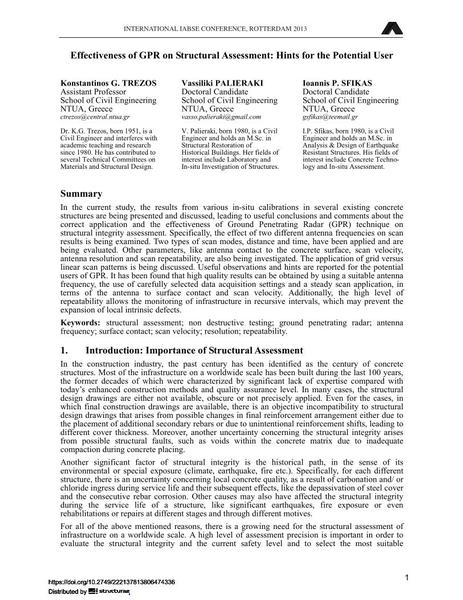Effectiveness of GPR on Structural Assessment: Hints for the Potential User

|
|
|||||||||||
Détails bibliographiques
| Auteur(s): |
Konstantinos G. Trezos
Vassiliki Palieraki Ioannis P. Sfikas |
||||
|---|---|---|---|---|---|
| Médium: | papier de conférence | ||||
| Langue(s): | anglais | ||||
| Conférence: | IABSE Conference: Assessment, Upgrading and Refurbishment of Infrastructures, Rotterdam, The Netherlands, 6-8 May 2013 | ||||
| Publié dans: | IABSE Conference, Rotterdam, May 2013 | ||||
|
|||||
| Page(s): | 102-103 | ||||
| Nombre total de pages (du PDF): | 8 | ||||
| Année: | 2013 | ||||
| DOI: | 10.2749/222137813806474336 | ||||
| Abstrait: |
In the current study, the results from various in-situ calibrations in several existing concrete structures are being presented and discussed, leading to useful conclusions and comments about the correct application and the effectiveness of Ground Penetrating Radar (GPR) technique on structural integrity assessment. Specifically, the effect of two different antenna frequencies on scan results is being examined. Two types of scan modes, distance and time, have been applied and are being evaluated. Other parameters, like antenna contact to the concrete surface, scan velocity, antenna resolution and scan repeatability, are also being investigated. The application of grid versus linear scan patterns is being discussed. Useful observations and hints are reported for the potential users of GPR. It has been found that high quality results can be obtained by using a suitable antenna frequency, the use of carefully selected data acquisition settings and a steady scan application, in terms of the antenna to surface contact and scan velocity. Additionally, the high level of repeatability allows the monitoring of infrastructure in recursive intervals, which may prevent the expansion of local intrinsic defects. |
||||
